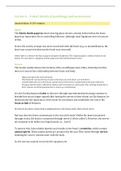Lecture 6 – A short history of psychology and neuroscience
Ancient Ideas: 0-16th century
Egypt
The Edwin Smith papyrus shows that Egyptian doctors already believed that the brain
played an important role in controlling behavior, although most Egyptians were not aware
of this.
In fact, the society at large was more concerned with the heart (e.g., in mummification, the
heart was conserved whereas the brain was removed).
Edwin Smith is a collector who buys a papyrus and gets it deciphered. This ‘surgical papyrus’ contains a bunch of case
studies. For each, there is a diagnosis of brain injury and a link with behavioral control.
Greece
The Greeks mainly discuss the location of the soul (Hippocrates, Plato, Aristotle), but this
does not concern the relationship between brain and body.
- Hippocrates places the soul in the brain.
- Plato thinks the soul has three parts (one in the brain, one in the heart, one in the liver).
- Aristotle thinks the soul is in the heart, and the brain (cold) serves to counterbalance the heat of the heart.
He argues that the heart is affected by emotion and it is located in a central point. Plus, all living animals have a
heart, whereas not all living animals have a brain (e.g., invertebrates).
It is the Greek physician Galen to discover through experimentation that pigs continue to
breathe but can no longer squeak after having the nerves in their throat cut. By doing so, he
demonstrates the importance of the brain for movement and establishes the role of the
brain as hub of behavior.
He dissects and draws animal brains adapting them to the human skull, which results weird.
But how does the brain communicate to the rest of the body? Unlike the heart (connected
through veins), the brain is connected through nerves (‘white cables’). However, the nerves
are assumed to be hollow (no liquid inside, so… how?)
To answer this, Galen thinks that the soul resides in the brain’s ventricles, which contain
animal spirits. These animal spirits are produced by the soul. They travel through nerves,
enabling the soul to communicate with the body.
So, the nervous system is not into the equation yet.
, Limited insights – 16th to 18th century
Renaissance
Vesalius made dissections on humans and focused on three ventricles. He is the first to
propose localization of function, as he thinks different functions rely on different
ventricles:
1st is common sense (fantasy), 2nd is thought, 3rd is memory.
However, he agrees with Galen on the animal spirits’ stuff.
Galen’s texts renew interest in the behavioral consequences of brain injury (e.g., it was
observed how some with brain injury developed speech problems; it seemed like their
memory for words had disappeared or was no longer accessible). How bizarre.
17th-18th century
Increasing focus on the brain itself (solid parts, rather than ventricles).
Willis distinguishes grey (outer layer) and white (inner layer) matter. The grey matter (i.e.,
cortex, rind) was thought to serve memory and will. Willis is the first one to doubt the
existence of animal spirits. He instead hypothesizes the presence of fluid inside of nerves.
He supports localization and argues that the higher brain structures serve higher functions,
whereas elementary functions sit in the lower brain structures.
However, the cortex is thought to be numb: if you expose it and touch it the animal seems
undisturbed. If you do the same with the white matter, the animal screams and often dies.
This was a point against the involvement of the cortex.
Growing interest in reflexes:
- Descartes is interested in reflexes, which fit his mechanistic world view: a sensory
impression reaches the brain and bounces back to the body through a motor
command, resulting in a reflexive movement. This leads him to dualism.
- Galen is also interested in reflexes, which he thought to reflect ‘sympathy’ between
the body parts, in the sense that one part responds sympathetically to another’s
distress. This view named the sympathetic nervous system.
- Procháska argues that reflexes are controlled by the spinal cord, rather than the
brain.
These insights do not lead to improved treatment, yet.





